Recycling-Oriented Design of the Al-Zn-Mg-Ca Alloys †
Abstract
:1. Introduction
2. Materials and Methods
3. Results
3.1. Principles of the Alloy Design
3.2. Substantiation of the Alloying Content and Heat Treatment Route
- (1)
- Zn and Mg must provide a more than sufficient hardening after solid solution treatment and ageing. With regards to further practical applications, their amount (8 wt.% and 3 wt.%) was chosen from concentrations in the established ultra-high-strength 7085 alloy and our previous studies. For example, the latter showed that excessive Zn (>10 wt.%) may bring a lowering of equilibrium solidus and further grain-boundary melting after homogenizing annealing at 500 °C. Additionally, several works [22,23,24] have revealed that an increase in Zn content over 9 wt.% causes a decrease in ductility, rather than an increase in strength. When considering Mg, the content chosen was the maximum for commercial alloys [25]. An increase in Mg is practically used for increasing hot tearing resistance, while the toughness, essential for wrought alloys, may be tuned by lowering the Mg:Zn ratio. In addition, as is shown in Figure 2a both Zn and Mg remarkably narrow the area of (Al) solidification. However, Zn acts in a slightly stronger manner and may bring some risks regarding an unacceptable primary solidification of intermetallics.
- (2)
- Ca provides the formation of the eutectic-origin phases, which may also include Fe and Si (Al10CaFe2, Al2CaSi2). An increase in the Ca content may bring far more benefits in improving density, corrosion resistance, and casting properties. However, to the best of our knowledge, the Ca content must be controlled down to 2 wt.% due to limitations in industrial emission spectrometry for chemical analysis. Besides, the higher the Ca, the lower the Zn in (Al), due to the incrementing (Al, Zn)4Ca phase, bringing a loss of strength. In addition to the primary solidification, an increase in Ca from 1 wt.% to 2 wt% shifts the equilibrium line Al3Fe/(Al) by 0.12 wt.%. Hence, further Ca alloying may bring Fe-bearing primary phase at a given Fe and Si content.
- (3)
- Fe and Si contents each of 0.5 wt.% were chosen for the sake of sustainability, providing opportunities to use commercially pure primary aluminum (Fe + Si < 0.5 wt.%), packing, or electrical scrap of grades like 1100 and 8176 (Fe + Si < 1 wt.%). Indeed, these elements aggravate the performance of the alloy mainly due to the possible formation of adverse Al3Fe and Mg2Si phases. According to preliminary calculations, even if the formation of the Al8Fe2Si could be achieved by an increase in Si content, it also would lead to excessive Mg2Si phase and lowering of the effective Mg in Al. In this respect, based on our previous studies we advocated speculating on the beneficial Ca effect for favouring the microstructure due to the formation of ternary phases.
3.3. Samples in As-Cast and Heat-Treated Conditions
3.4. Deformation and Recycling Feasibility
4. Conclusions
- Recycling-tolerant Al-Zn-Mg-Ca aluminum alloys may be formulated via appropriate alloying and solidification conditions provided they have an as-cast structure including multiphase eutectic with differentiated insoluble intermetallics, which must contain impurities of recycling origin, primarily, Fe and Si. Accordingly, the solidification path and solidus temperature must provide the opportunity for high-temperature heat-treating aimed at tuning the shape of the eutectic phase for favouring performance.
- The phase composition and solidification path of the Al-Zn-Mg-Ca-Fe-Si alloys showed the presence of multiphase eutectic (Al)+Al3Fe+Al2CaSi2+Al4Ca under equilibrium solidus of 540 °C. However, a first annealing step at 450 °C was required for the dissolving of the non-equilibrium eutectic solidified at ~480 °C.
- In comparison to AlZnMgFeSi and AlZnMg2CaFeSi, the AlZnMg1CaFeSi exhibited a sufficiently fine as-cast structure, including differentiated constituents of equilibrium origin Al3Fe, Al10CaFe2, Al2CaSi2, and (Al.Zn)4Ca. After two-step annealing and quenching they were mostly spheroidized, and the non-equilibrium T phase was dissolved in (Al).
- A synergetic Ca, Fe, and Si effect on the hardening was described. While the Al-Zn-Mg-Ca alloys lose their performance due to Zn dissolution in (Al, Zn)4Ca phase, joint Ca, Fe, and Si alloying promotes the formation of additional Ca-bearing phases and the increase in effective solute Zn in (Al). The AlZnMg1CaFeSi in the T6 condition possessed a similar hardness value as the base AlZnMg alloy (195 HV vs. 200 HV).
- The composition of the AlZnMg1CaFeSi alloy may serve as a sufficient basis for the design of new high-strength recycling-tolerant wrought aluminum alloys, since it shows good microstructure, similar to that of 6xxx alloys, excellent hardening response, appropriate processability at metal formation, and may be formulated from Fe- and Si-rich aluminum scrap.
Author Contributions
Funding
Institutional Review Board Statement
Informed Consent Statement
Conflicts of Interest
References
- Raabe, D.; Tasan, C.C.; Olivetti, E.A. Strategies for improving the sustainability of structural metals. Nature 2019, 575, 64–74. [Google Scholar] [CrossRef] [PubMed]
- Trowell, K.A.; Goroshin, S.; Frost, D.L.; Bergthorson, J.M. Aluminum and its role as a recyclable, sustainable carrier of renewable energy. Appl. Energy 2020, 275, 115112. [Google Scholar] [CrossRef]
- Haraldsson, J.; Johansson, M.T. Review of measures for improved energy efficiency in production-related processes in the aluminum industry—From electrolysis to recycling. Renew. Sustain. Energy Rev. 2018, 93, 525–548. [Google Scholar] [CrossRef]
- Wallace, G. Production of secondary aluminum. In Fundamentals of Aluminium Metallurgy Production, Processing and Applications, 1st ed.; Lumley, R., Ed.; Woodhead Publishing Ltd.: Cambridge, UK, 2011; pp. 70–82. [Google Scholar] [CrossRef]
- Das, S.K.; Green, J.A.S.; Kaufman, J.G. The development of recycle-friendly automotive aluminum alloys. JOM 2007, 59, 47–51. [Google Scholar] [CrossRef]
- Cinkilic, E.; Ridgeway, C.D.; Yan, X.; Luo, A.A. A formation map of iron-containing intermetallic phases in recycled cast aluminum alloys. Metall. Mater. Trans. A 2019, 50A, 5945–5956. [Google Scholar] [CrossRef]
- Park, J.O.; Paik, C.H.; Huang, Y.H.; Alkire, R.C. Influence of Fe-Rich intermetallic inclusions on pit initiation on aluminum alloys in aerated NaCl. J. Electrochem. Soc. 1999, 146, 517–523. [Google Scholar] [CrossRef]
- Belov, N.A.; Aksenov, A.A.; Eskin, D.G. Iron in Aluminum Alloys: Impurity and Alloying Element; Taylor & Francis: London, UK, 2002; 360p. [Google Scholar]
- Enginsoy, H.M.; Bayraktar, E.; Katundi, D.; Gatamorta, F.; Miskioglu, I. Comprehensive analysis and manufacture of recycled aluminum-based hybrid metal matrix composites through the combined method; sintering and sintering + forging. Compos. Part B: Eng. 2020, 194, 108040. [Google Scholar] [CrossRef]
- Hyodo, A.; Bolfarini, C.; Ishikawa, T.T. Chemistry and tensile properties of a recycled AA7050 via spray forming and ECAP/E. Mater. Res. 2012, 15, 739–748. [Google Scholar] [CrossRef]
- She, H.; Chu, W.; Shu, D.; Wang, J.; Sun, B. Effects of silicon content on microstructure and stress corrosion cracking resistance of 7050 aluminum alloy. Trans. Nonferrous Met. Soc. China 2014, 24, 2307–2313. [Google Scholar] [CrossRef]
- Kazeem, A.; Badarulzaman, N.A.; Ali, W.F.F.W. Relating fractographic analysis to yield strength of novel X7475 (Al–Zn–Mg–Cu) alloys produced by recycling aluminum beverage cans. Mater. Lett. 2020, 262, 127067. [Google Scholar] [CrossRef]
- Kazeem, A.; Badarulzaman, N.A.; Ali, W.F.F.W. Optimization of wear and hardness of Al–Zn–Mg–Cu alloy fabricated from recycled beverage can using response surface methodology. Sn Appl. Sci. 2020, 2, 1210. [Google Scholar] [CrossRef]
- Belov, N.A. Sparingly alloyed high-strength aluminum alloys: Principles of optimization of phase composition. Met. Sci. Heat Treat. 2012, 53, 420–427. [Google Scholar] [CrossRef]
- Akopyan, T.K.; Belov, N.A. Calculation-experimental study of the phase composition of Al-Zn-Mg-(Cu)-Ni-Fe aluminum alloys. Russ. Metall. 2013, 7, 545–552. [Google Scholar] [CrossRef]
- Akopyan, T.K.; Belov, N.A. Approaches to the design of the new high-strength casting aluminum alloys of 7xxx series with high iron content. Non-Ferr. Met. 2016, 1, 20–27. [Google Scholar] [CrossRef]
- Belov, N.A.; Naumova, E.A.; Akopyan, T.K.; Doroshenko, V.V. Phase diagram of the Al-Ca-Fe-Si system and its application for the design of aluminum matrix composites. JOM 2018, 70, 2710–2715. [Google Scholar] [CrossRef]
- Belov, N.; Akopyan, T.; Korotkova, N.; Murashkin, M.; Timofeev, V.; Fortuna, A. Structure and Properties of Ca and Zr Containing Heat ResistantWire Aluminum Alloy Manufactured by Electromagnetic Casting. Metals 2021, 11, 236. [Google Scholar] [CrossRef]
- Shurkin, P.K.; Dolbachev, A.P.; Naumova, E.A.; Doroshenko, V.V. Effect of iron on the structure, hardening and physical properties of the alloys of the Al-Zn-Mg-Ca system. Tsvetnye Met. 2018, 5, 69–77. [Google Scholar] [CrossRef]
- Shurkin, P.K.; Belov, N.A.; Musin, A.F.; Samoshina, M.E. Effect of calcium and silicon on the character of solidification and strengthening of the Al–8% Zn–3% Mg Alloy. Phys. Met. Met. 2020, 121, 135–142. [Google Scholar] [CrossRef]
- Thermo-Calc Software—Computational Materials Engineering. Available online: http://www.thermocalc.com (accessed on 1 February 2021).
- Shu, W.X.; Hou, L.G.; Zhang, C.; Zhang, F.; Liu, J.C.; Liu, J.T.; Zhuang, L.Z.; Zhang, J.S. Tailored Mg and Cu contents affecting the microstructures and mechanical properties of high-strength Al-Zn-Mg-Cu alloys. Mater. Sci. Eng. A 2016, 657, 269–283. [Google Scholar] [CrossRef]
- Chen, Z.; Mo, Y.; Nie, Z. Effect of Zn content on the microstructure and properties of super-high-strength Al-Zn-Mg-Cu alloys. Metall. Mater. Trans. 2013, 44A, 3910–3920. [Google Scholar] [CrossRef]
- Shin, J.; Kim, T.; Kim, D.E.; Kim, D.; Kim, K. Castability and mechanical properties of new 7xxx aluminum alloys for automotive chassis/body applications. JALCOM 2017, 698, 577–590. [Google Scholar] [CrossRef]
- The Aluminium Association, International Alloy Designations and Chemical Composition Limits for Wrought Aluminium and Wrought Aluminium Alloys. The Aluminium Association. Available online: https://www.aluminum.org/sites/default/files/Teal%20Sheets.pdf (accessed on 1 February 2021).
- Shurkin, P.K.; Belov, N.A.; Musin, A.F.; Aksenov, A.A. Novel high-strength casting Al−Zn−Mg−Ca−Fe aluminum alloy without heat treatment. Russ. J. Non-Ferr. Met. 2020, 61, 179–187. [Google Scholar] [CrossRef]
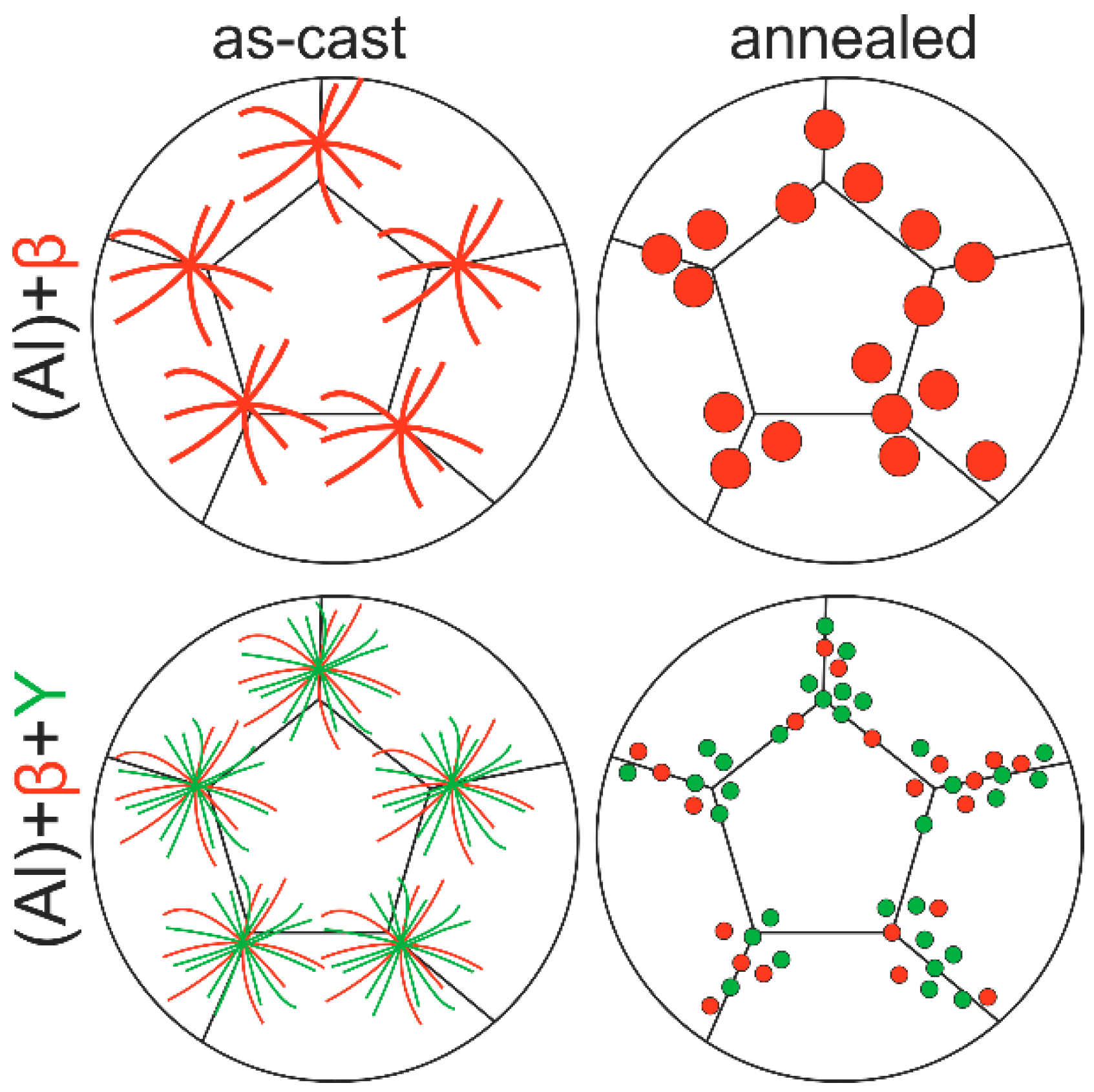
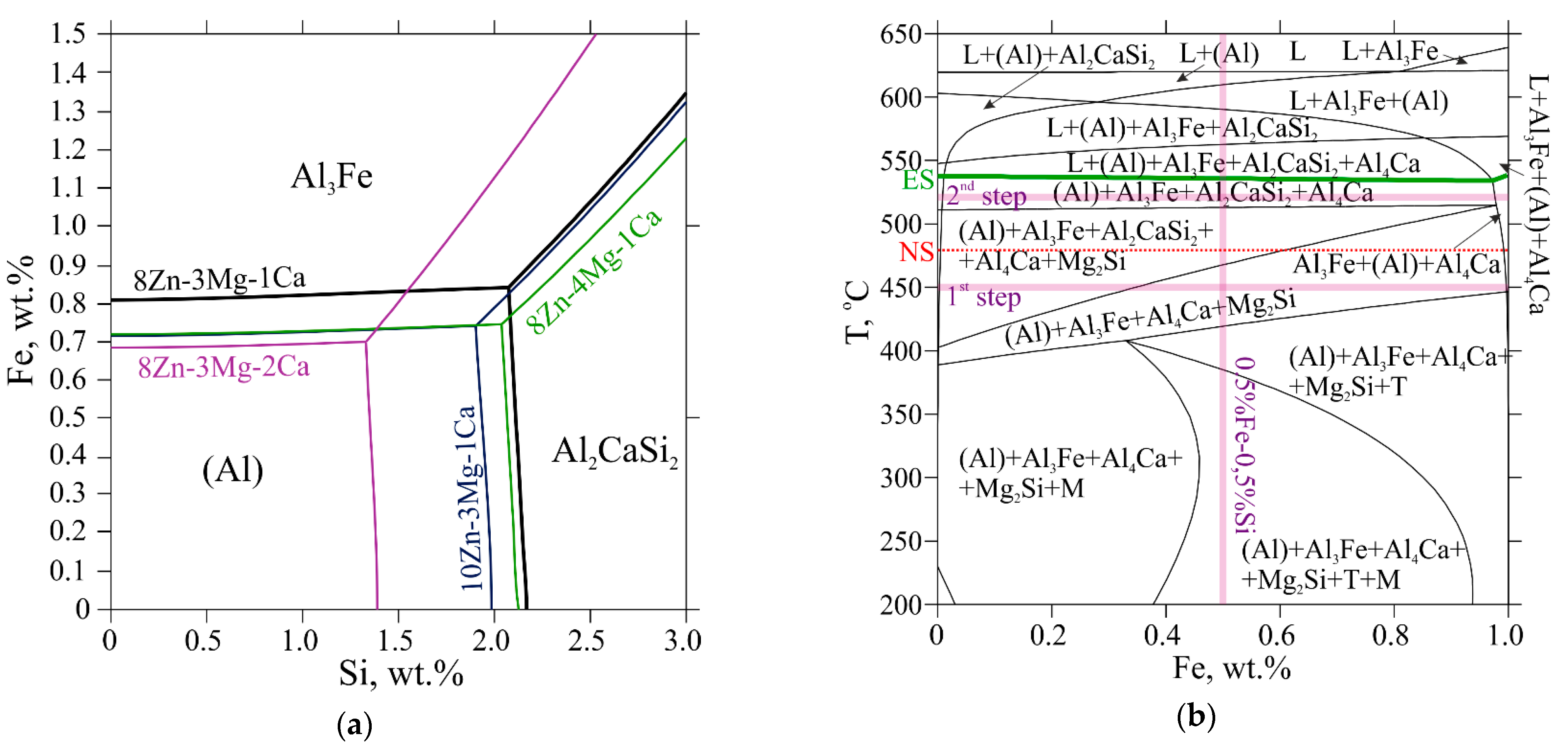
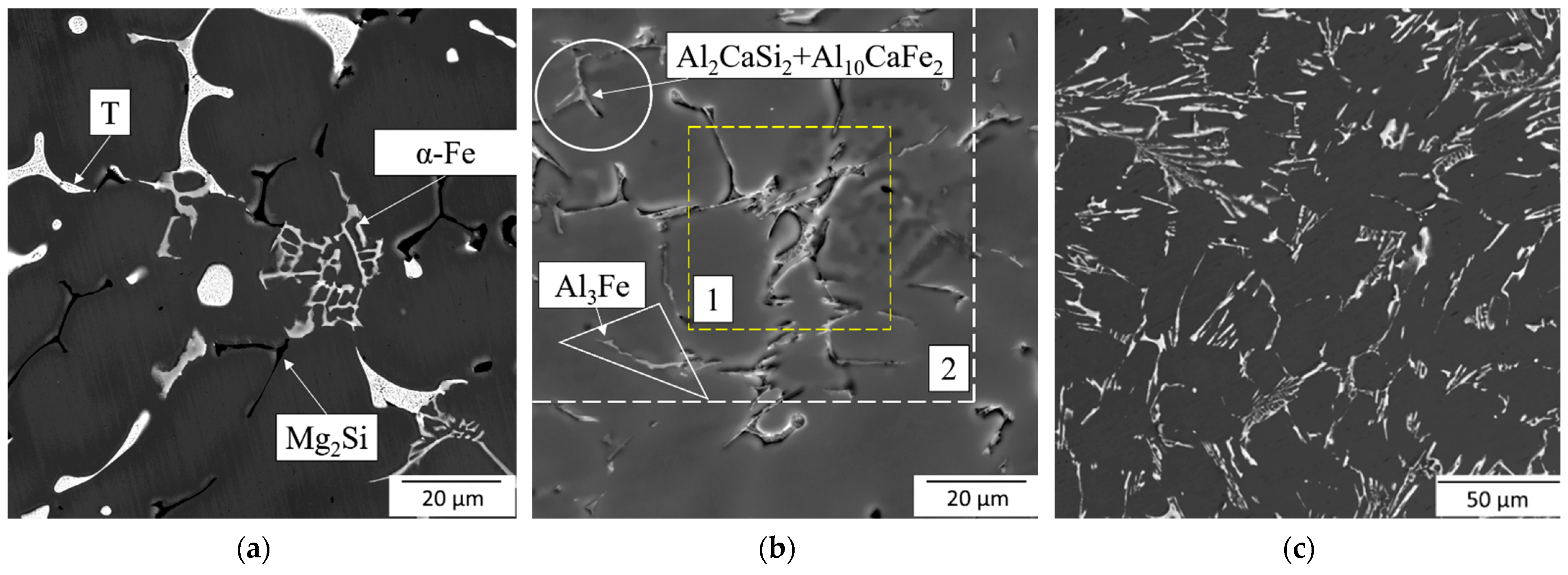

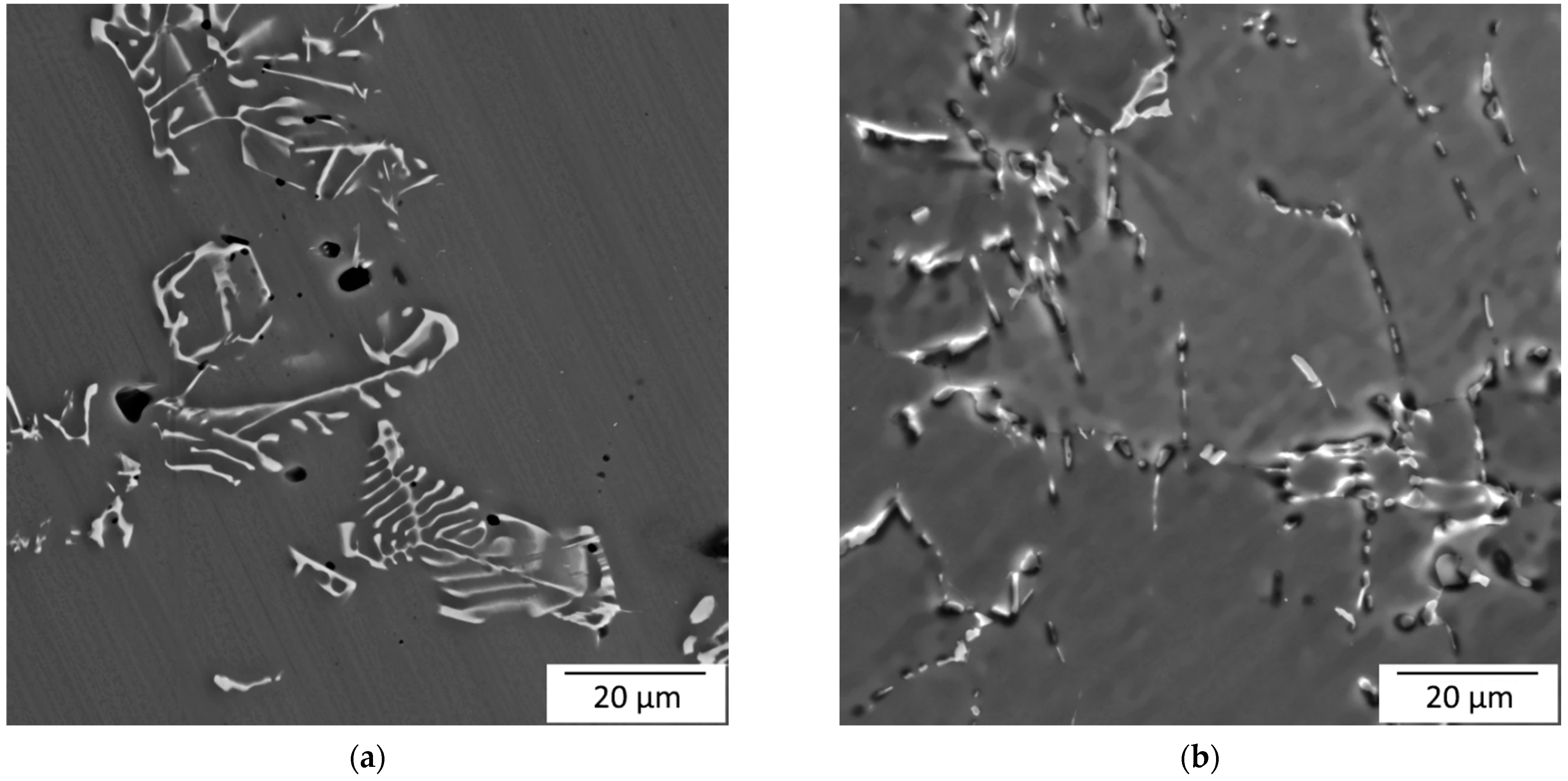
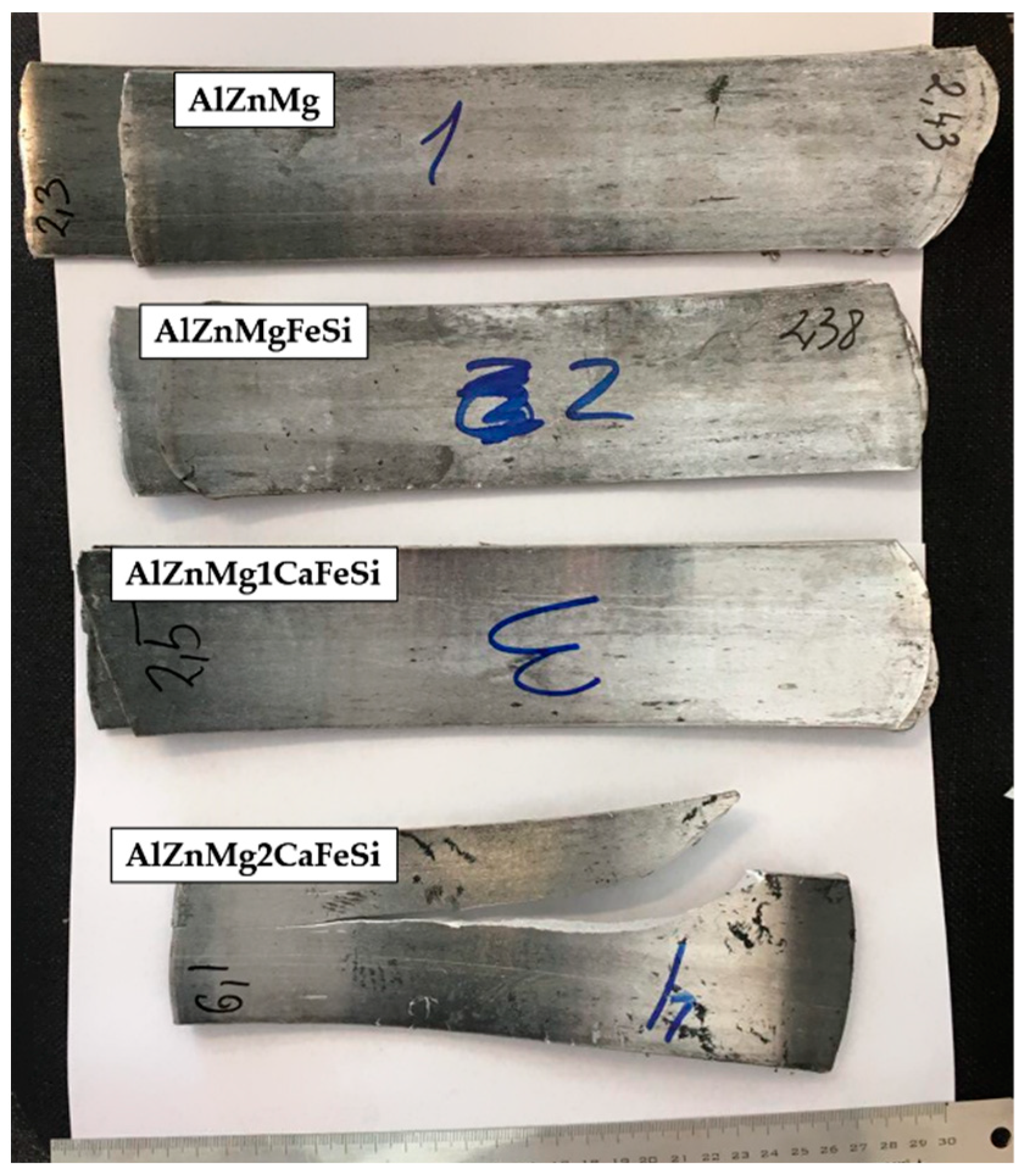
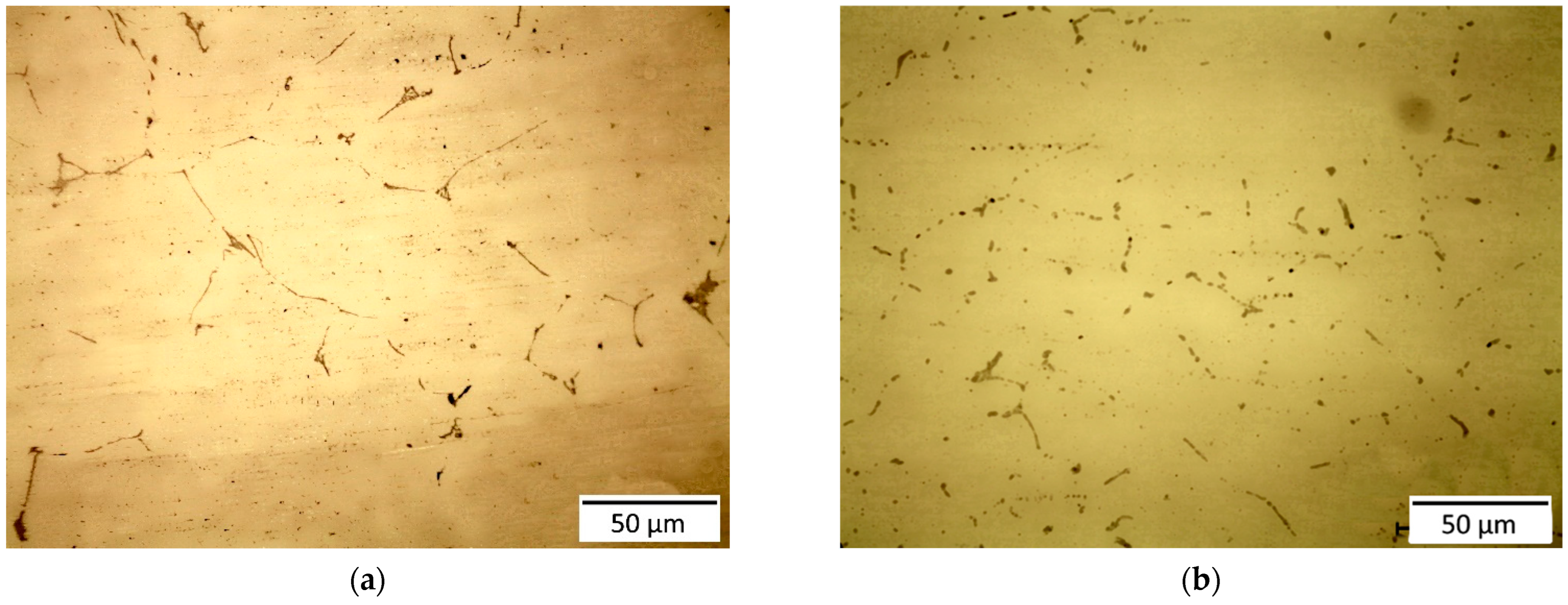
| Alloy | Nominal and Actual Concentrations (in Brackets), wt.% | |||||
|---|---|---|---|---|---|---|
| Zn | Mg | Ca | Fe | Si | Al | |
| AlZnMg | 8(8.1) | 3 (2.8) | 0 | 0 | 0 | Balance |
| AlZnMgFeSi | 8 (7.9) | 3 (2.9) | 0 | 0.5(0.51) | 0.5(0.49) | Balance |
| AlZnMg1Ca | 8 (7.7) | 3 (2.6) | 1(0.9) | 0 | 0 | Balance |
| AlZnMg2Ca | 8 (7.8) | 3 (3.1) | 2(1.8) | 0 | 0 | Balance |
| AlZnMg1CaFeSi | 8 (8.0) | 3 (2.8) | 1(0.9) | 0.5(0.55) | 0.5(0.51) | Balance |
| AlZnMg2CaFeSi | 8 (7.7) | 3 (2.9) | 2(1.9) | 0.5(0.52) | 0.5(0.50) | Balance |
| Phases | Element | |||||
|---|---|---|---|---|---|---|
| Al | Zn | Mg | Ca | Fe | Si | |
| Phases forming during solidification | ||||||
| (Al,Zn)4Ca | + | + | - | + | - | - |
| Al10CaFe2 | + | - | - | + | + | - |
| Al2CaSi2 | + | - | - | + | - | + |
| Al3Fe | + | - | - | - | + | - |
| α-Fe (Al8Fe2Si) | + | - | - | - | + | + |
| β-Fe (Al5FeSi) | + | - | - | - | + | + |
| Mg2Si | - | - | + | - | - | + |
| T (Al2Mg3Zn3) | + | + | + | - | - | - |
| M (MgZn2) | - | + | + | - | - | - |
| Precipitates | ||||||
| T (Al2Mg3Zn3) | + | + | + | - | - | - |
| M (MgZn2) | - | + | + | - | - | - |
| Alloy | Phase Transformation Temperatures (Calculation/Experimental), °C 1 | |||||||
|---|---|---|---|---|---|---|---|---|
| L1 | Al3Fe 2 | Mg2Si | Al4Ca 3 | Al2CaSi2 | T | NS 2 | ES 2 | |
| AlZnMg | 632/628 | 483/474 | 482 | 559 | ||||
| AlZnMgFeSi | 627/623 | 615/613 | 564/561 | 480/471 | 474 | 560 | ||
| AlZnMg1Ca | 626/623 | 566/589 | 482/470 | 478 | 545 | |||
| AlZnMg2Ca | 619/617 | 578/594 | 482/468 | 477 | 540 | |||
| AlZnMg1CaFeSi | 620/616 | 610/- | 526/- | 559/- | 589/585 | 482/468 | 477 | 538 |
| AlZnMg2CaFeSi | 613/610 | 605/- | 526/- | 574/- | 591/598 | 481/- | 478 | 535 |
Publisher’s Note: MDPI stays neutral with regard to jurisdictional claims in published maps and institutional affiliations. |
© 2021 by the authors. Licensee MDPI, Basel, Switzerland. This article is an open access article distributed under the terms and conditions of the Creative Commons Attribution (CC BY) license (https://creativecommons.org/licenses/by/4.0/).
Share and Cite
Shurkin, P.; Belov, N.; Akopyan, T.; Karpova, Z. Recycling-Oriented Design of the Al-Zn-Mg-Ca Alloys. Mater. Proc. 2021, 3, 7. https://doi.org/10.3390/IEC2M-09250
Shurkin P, Belov N, Akopyan T, Karpova Z. Recycling-Oriented Design of the Al-Zn-Mg-Ca Alloys. Materials Proceedings. 2021; 3(1):7. https://doi.org/10.3390/IEC2M-09250
Chicago/Turabian StyleShurkin, Pavel, Nikolay Belov, Torgom Akopyan, and Zhanna Karpova. 2021. "Recycling-Oriented Design of the Al-Zn-Mg-Ca Alloys" Materials Proceedings 3, no. 1: 7. https://doi.org/10.3390/IEC2M-09250
APA StyleShurkin, P., Belov, N., Akopyan, T., & Karpova, Z. (2021). Recycling-Oriented Design of the Al-Zn-Mg-Ca Alloys. Materials Proceedings, 3(1), 7. https://doi.org/10.3390/IEC2M-09250






